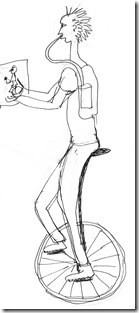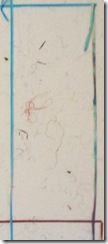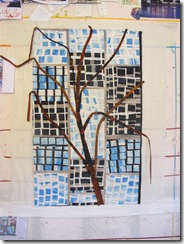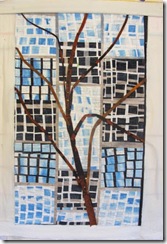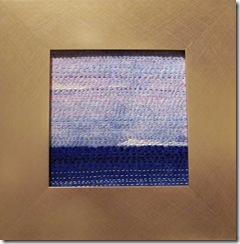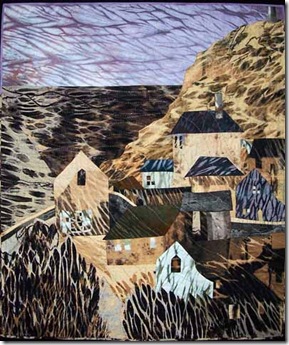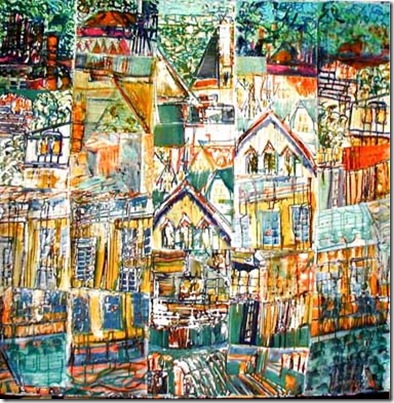 City of Garlic and Sapphires (60 x 60)
City of Garlic and Sapphires (60 x 60)
So many quilters I know take lots of classes and really look forward to them as the highlights of their year. They certainly are tremendous social events, it’s great to be in a room full of high energy folk all doing the same thing and that activity being one that they all love to do. Where else in life d’you come across that?!!
But what else do people hope to get from their workshops? Certainly a new technique is one thing, a new process, an actual object, something you can carry home with you (the thousand dollar pot holder!), but how do these really help you to draw out of yourself your own creativity?
In Ancient Greece, Socrates described education as the drawing out, or leading out (from the Latin e (out of) ducere (lead) ) of that which was already within the student:
"I cannot teach anybody anything, I can only make them think."
Of course, this comment (though apt!) is wildly out of context and his pupils already had a lot of basic skills and he was teaching philosophy not quilt making!! Though maybe the world would be very different if our “leaders” (generally leading us into trouble rather than out of it, alas) did get together to make quilts.
In Ancient Greece (about 5th century BC) there were also peripatetic teachers known as Sophists whose aim was much closer to that of many colleges today i.e. to teach students the knowledge and skills needed to obtain power, money and high political office. Commanding high fees from their students, they promised them they would impart to them the skills to be successful and productive.
So should the quilt teacher in planning his or her workshops be thinking along Socratic lines, or Sophist ones? Should workshops be about encouragement, support and fun? Should they be about drawing out of the person that which is already within her/him? Or should they be teaching the students to make quilts like their own award winning work? (with the unspoken promise that thereby they will be gaining the skills to get a quilt accepted into Quilt National or Paducah or Houston.)
Let’s look at what some art teachers have written (I hope quilt teachers will write in with their opinions!):
Robert Liberace feels that it is essential that teachers help their students to learn the ideas and traditions of the great artists of history “as a path to creating the most interesting and relevant art – for the powerful ideas of the past can point to revolutionary ideas today”. Certainly all those students who learned about the improvisational work of the Gee’s Bend Quilters, the Oakland quilters, Anna Williams and the African banner makers in Benin and adjoining countries, and aboriginal cultures did exactly this. They took older ideas and with them created quite revolutionary quilts. People in small country towns and guilds are still horrified by them!! Those “old” ideas definitely formed a path to quilts that are extremely interesting and relevant. I, myself, was being quite stultified by the repetition of symmetrical tradition in dull calico prints and was very happy to be lead out of that dusty hidebound arena!
Susan Lyon, on the other hand, stresses preparation when she teaches. She feels its important to approach your work with “good habits, to guard against mistakes” – this does sound a bit like my Catholic school education! But, as she points out, preparation at the outset will help considerably to avoid waste, frustration and loss of time when you have to fix basic mistakes as you reach the end of a project. The “good habit” of looking before you leap shouldn’t stifle creativity if, in that looking, you allow yourself wide open thinking eyes! She observes that “most students want to jump right in, without patience, without deliberate thinking”. In a culture which largely encourages buying on impulse and rote learning you can certainly see how this happens. However, I find that while some students in workshops are really impatient to get cutting and sewing, others are hungry for a more reflective approach, they would like to know what they are doing. For myself ,it was the continual frustration of having to undo, of bouncing up and down to the design wall trying this color and that and the other, that led me to consider that there might be another way.
But we must not be so cautious that we proceed only upon the well trodden path. Sharon Sprung thinks that it is most important to help the students gain “respect for the somewhat ineffable but critical Art of Seeing – to encourage an inquisitiveness into both the known and unknown – and to make a commitment to hard work, risk taking and tenacity”.
So, which do you prefer in your teacher? The Socratic approach – a thoughtful drawing out of what lies within you and being able to evaluate it along logical and critical lines? Or, the Sophist premise that if you gain all the techniques and processes you will have the tools to reach the top? It’s a puzzle! Do write and let me know what you think, and also your feelings about what you see happening in all this quilt teaching that is going on.
As always, if you have been, thanks for reading! And, by the way, the quilt at the top is based on my thinking about my images of Oxford, a major city for education and industry and is based on a particular process (deconstructed screen printing) – an amalgam of both thought and technique!
The comments from art teachers were drawn from an article in the February 2012 issue of International Artist.
Elizabeth
